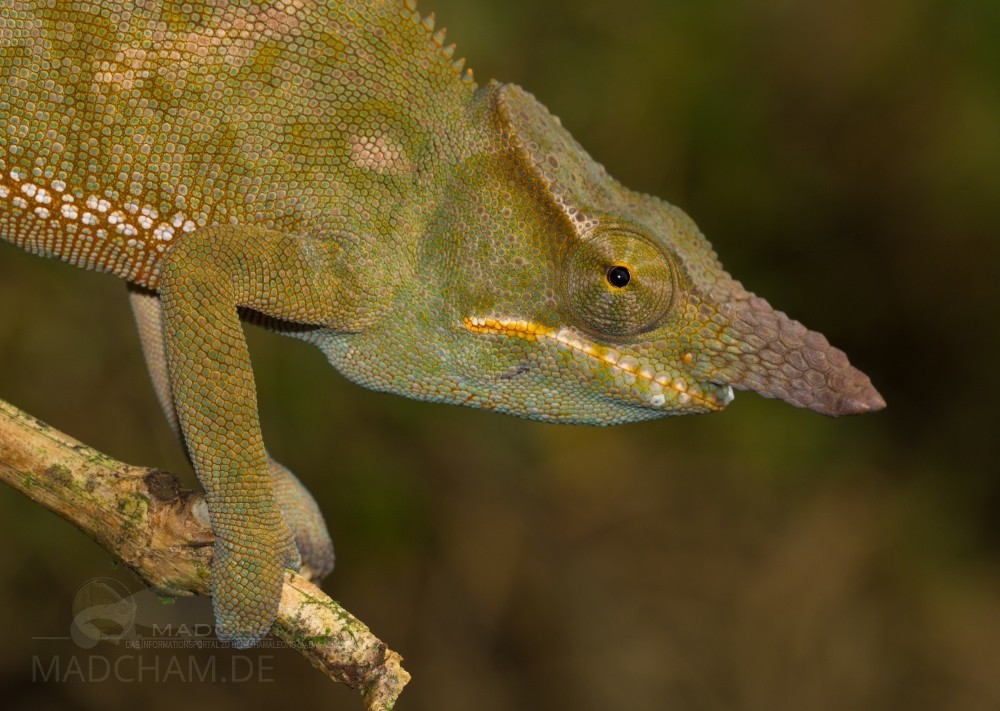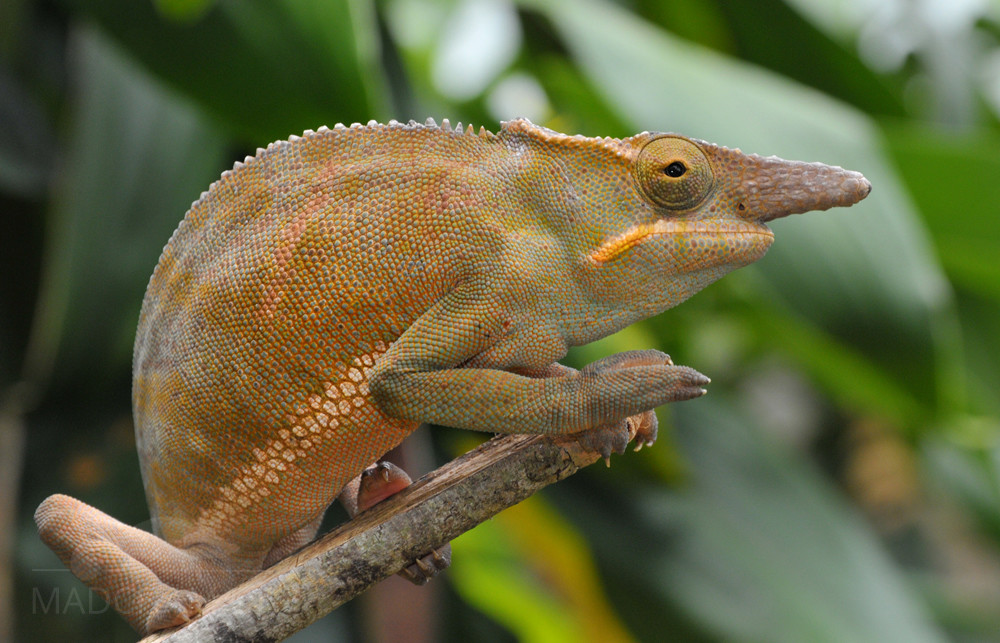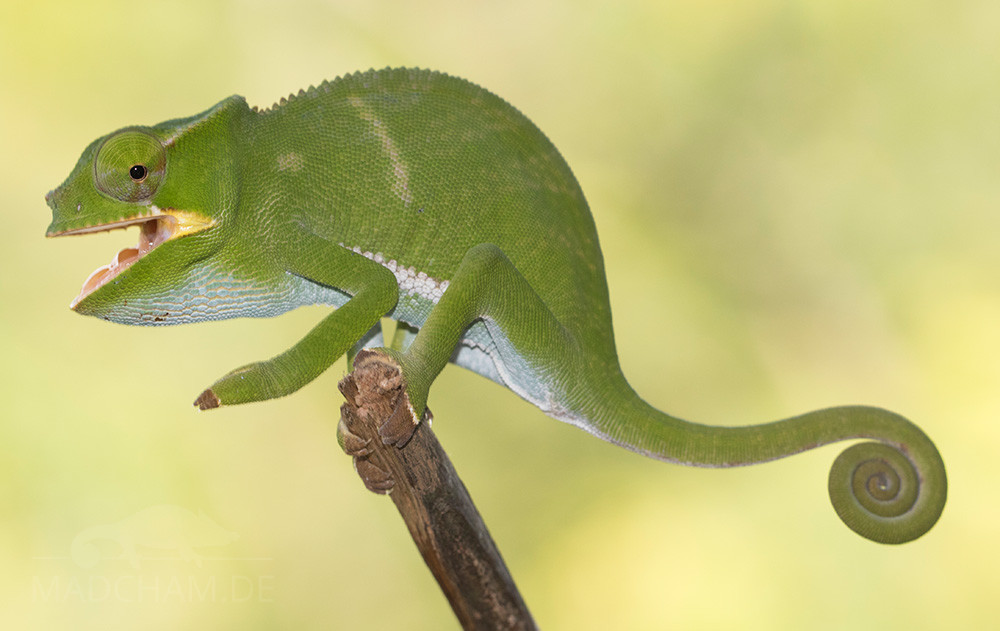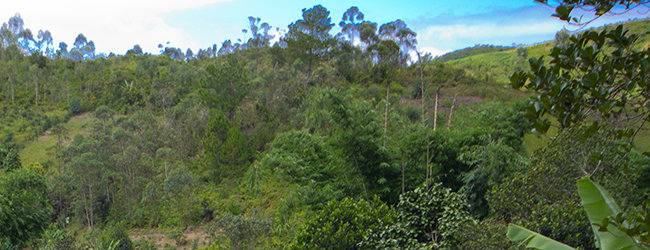2011-13 no specimens, 2014-23 each 500 specimens for legal export
First description:
Origin of the species name:
The French zoologist and geologist Alexandre Brongniart taught about mineralogy at the Natural History Museum in Paris (France), but was also interested in reptiles and amphibians. In 1800 he described the species Furcifer bifidus on the basis of chameleon preparations available in the museum. He borrowed the species name from the Latin bifidum, which means “divided in two” and alludes to the male’s nasal process.
Distribution:
Furcifer bifidus lives in the rainforest along the east coast of Madagascar, at heights of approximately 1000 meters above sea level. The distribution area extends from Andasibe eastwards to Toamasina (Tamatave) and into the northern direction via Fenoarivo until Marojejy national park. A single found specimen in 2006 implies that the species could also occur in a humid region near the otherwise dust-dry Daraina, northeast of Vohémar. Until now, we found this species only in the area around Andasibe-Mantadia national park and occasionally around Vohimana as well as close to Mahambo on the east coast. There they have settled in secondary vegetation and coffee plantations in hilly sites. Further north, we have not seen Furcifer bifidus yet. Due to increasing slash-and-burn agriculture along the east coast, Furcifer bifidus is one of many chameleon species with very fragmented populations in small residual forests.
Appearance and size:
With up to 42 cm total length in males and 30 cm in females, Furcifer bifidus belongs to the middle-sized chameleons of Madagascar. Both genders wear a low helmet, white or yellow lips, very homogenous scalation, and a white band along the body sides that has larger scales. When fired up, some specimens show an orange throat sac. The females are the prettier individuals in Furcifer bifidus, showing amazing colors. Usually, they are bright green with yellow bands, the top of the head is bright red with small blue dots. Gravid Furcifer bifidus wear bright blue dots spread over the whole body. In contrast, the males of this species are not very colorful with greyish, yellowish and green colors and dark bands, but have two distinct parallel nose appendages. In some individuals, these grow a little curved down. They have a dorsal ridge, but it is only visible in the area of the shoulders and disappears further back.
| Jan | Feb | Mar | Apr | May | Jun | Jul | Aug | Sep | Oct | Nov | Dec | |
| Average temperature | 23 | 24 | 23 | 23 | 22 | 19 | 19 | 19 | 20 | 21 | 22 | 23 |
| Minimum temperature | 20 | 20 | 20 | 19 | 18 | 15 | 15 | 15 | 15 | 16 | 18 | 19 |
| Maximum temperature | 27 | 27 | 27 | 27 | 25 | 23 | 23 | 23 | 24 | 25 | 26 | 27 |
| Rain days | 27 | 24 | 26 | 19 | 17 | 18 | 21 | 20 | 15 | 16 | 20 | 25 |
We have collected the data given above over several years with thermometers and hygrometers at the finding places of the chameleons. "Average temperature" means that values of a whole month have been calculated to one average value per month. For example all measured minimum temperature values of February have been calculated to one average minimum temperature for February. In plain language, this means single peak values of a day may be a little higher or lower than the average minimum and maximum temperatures. It is possible that a location has an average maximum temperature of 29°C, but one day during that month it had 33°C or even 35°C there.
Three examples of a daily course of temperatures in Andasibe in the rainy season can be found below. Both were recorded with data loggers in 2023.



The region around Andasibe with the associated forests of Mantadia, Mitsinjo and Analamazaotra lie in the eastern highlands of Madagascar at altitudes between 900 and 1250 m above sea level. During the day, the temperature may sometimes exceed 25°C, but the thermometer rarely climbs above 30°C, or only in sunspots. At night, temperatures plummet, especially during the dry season. 10° to 15° degrees are the rule.
Humidity in the rainforests around Andasibe is high all year round. During the rainy season it rains extensively every day, sometimes the rain lasts for days. But the dry season is not massively different either, except that it has slightly cooler temperatures overall and reaches lower temperatures at night. It still rains at least every other day. Rain, high humidity and a drop in temperature at night are therefore the central points of Andasibe's climate. In 2023, we measured relative humidity with data loggers on different days in Andasibe in the rainy season, the data can be found below.




 Tageszeit = day time, Sonne = sun, Halbschatten = half shade, Schatten = shade
Tageszeit = day time, Sonne = sun, Halbschatten = half shade, Schatten = shade
We have measured UVB data with a Solarmeter 6.5 in spring (March, April) at the peak of activity of chameleons in Madagascar. We always measured the values that a chameleon could maximally reach in its habitat.
| Jan | Feb | Mar | Apr | May | Jun | Jul | Aug | Sep | Oct | Nov | Dec | |
| Morning | 23,2 | 23,4 | 22,0 | 22,1 | 20,5 | 16,0 | 16,3 | 16,5 | 17,4 | 16,7 | 21,2 | - |
| Midday | 25,4 | 25,3 | 24,5 | 22,5 | 20,2 | 16,5 | 16,3 | 17,7 | 18,3 | 18,0 | 21,4 | - |
| Evening | 25,5 | 25,1 | 25,0 | 25,3 | 20,8 | 17,2 | 16,1 | 17,0 | 19,6 | 23,0 | 22,0 | - |
Between 21 March 2018 and 05 February 2019, we measured ground temperatures in the rainforest of Andasibe and surrounding areas (Analamazaotra, Andasibe, V.O.I.M.M.A. and Mitsinjo) about every other day - the table is the result of these measurements. Only in December no measurements were taken. detailed review can be found here. In total, we took 418 soil temperature measurements and measured an estimated 70 different locations in Andasibe and the surrounding area at a depth of 20 cm.
In 2023, in addition to other climate data, we also measured the air pressure at the locations we visited in Madagascar. The following data is from different days during the rainy season in Andasibe. On the X-axis is the time of day or night. In Madagascar, the day begins around 6 am, and night falls at 6 pm. The Y-axis shows the atmospheric pressure in hPa.



Habitat:
The following pictures show parts of the habitat of Furcifer bifidus in the region around Andasibe. Some are right from finding places of the species. The rainforests of this area mainly consist of young slender trees. Furcifer bifidus does not only inhabit the rainforests but also lives in secondary vegetation at the edges of the rainforest, in tamarind trees and other trees with widely protruding crowns. They prefer to roam around high up between the branches.
































